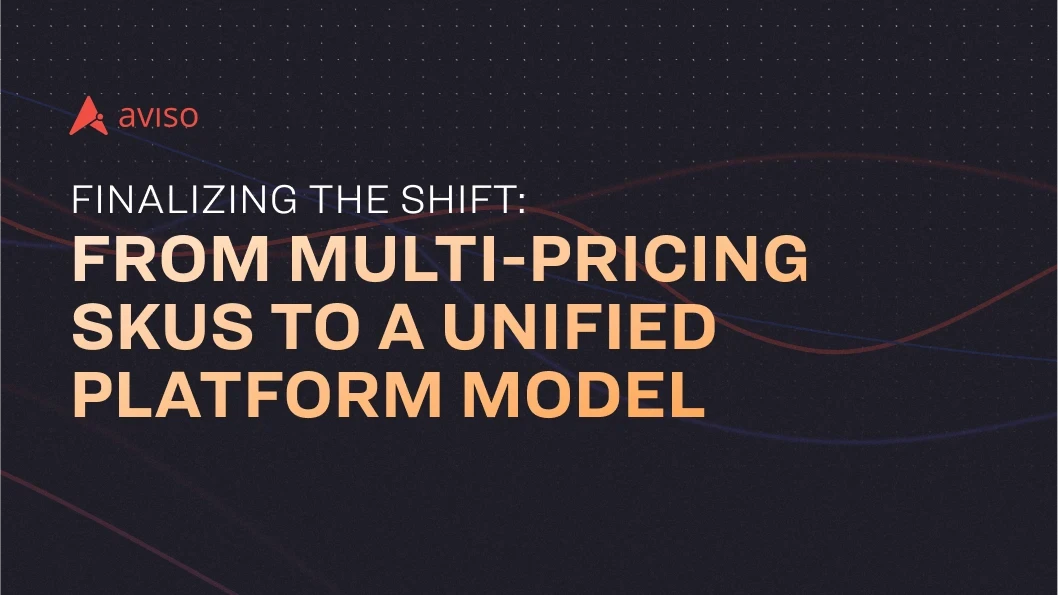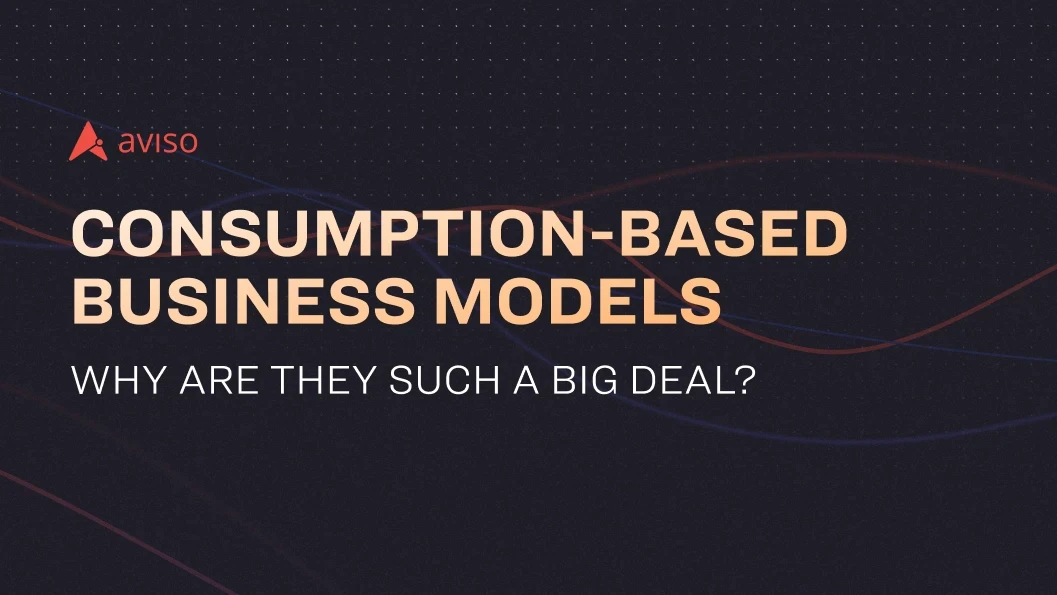Consumption Forecasting – The What, Why, and How
Feb 24, 2025
Consumption-based pricing, also known as usage-based pricing, is a strategy wherein customers are charged per unit of usage, rather than a fixed monthly rate. This pricing and value model has clearly become a competitive differentiator for leaders across go-to-market organizations.
In the current environment, SaaS applications ranging from infrastructure and developer tools to hybrid hardware-software offerings are seeing the most traction with consumption-based models.
Companies that offer usage-based pricing grow 38% faster than traditional subscription-based businesses because they are better at attracting and retaining customers.
However, while this pricing model’s transparency makes it easy to align costs with consumption, tracking revenue generation accurately and forecasting revenue for future quarters remain challenging. Managing multiple product-specific pricing structures within the same forecasting model further complicates revenue visibility, making it harder to scale and optimize pricing strategies.
Read on to discover what consumption forecasting is, why it’s critical for businesses adopting usage-based models, the key challenges companies face, and how Aviso’s AI-powered forecasting solves these challenges—helping businesses like New Relic achieve 98+% accuracy in annual committed revenue (ACR) forecasts while driving customer growth and retention.
What is Consumption Forecasting?
Consumption forecasting is the capacity to predict sales and revenue from a pay-as-you-go or run-rate business. It predicts how quickly resources will be spent in relation to a purchase order or contract.
For instance, customers at Amazon Web Services simply pay for the computing resources they use and can adjust their usage as needed to meet business needs. In this case, the business will realize revenue every time you use their product, rather than just once when you buy it.
Why Consumption Forecasting Matters
The consumption forecasting model examines key activity signals that contribute to higher and more predictable consumption in your organization, such as usage patterns and trends. These signals provide visibility into the current and future quarters pipeline.
Consumption forecasting helps salespeople achieve critical objectives, such as:
Identifying Upsell Opportunity: If a customer is consistently consuming above their contracted usage, it may be a good opportunity to upsell or negotiate a higher pricing plan.
Identifying Churn Risk: If a customer is consistently underutilizing their plan, it may be necessary to determine if it is a risk for churn and offer incentives or promotions to encourage the customer to continue using their product or service.
Improving Customer Satisfaction: Understanding how much of a product or service a customer is likely to use in the future allows them to make informed decisions about pricing and resource allocation leading to improved financial performance. This particular benefit can help sales reps win new customers.
Furthermore, consumption forecasting provides actionable steps to reps that can help them upsell, and pull in renewals earlier, to mitigate the potential churn risk. Reps can also identify the accounts that are approaching their overages or failing to achieve their growth metrics.
Consumption forecasting also helps CFOs understand the revenue recognition for each customer by forecasting expected revenue and when it will be realized. This allows a better understanding of the financial position of the business to make informed decisions about optimized resource allocation and investment.
Challenges with Forecasting Consumption
Forecasting customer consumption can be a challenging task for companies, especially in today's fast-paced and constantly changing market where customers’ usage can change quickly.

Unstructured data present in data warehouses: One of the major challenges is the huge amounts of unstructured data in data warehouses, such as Snowflake and Oracle. As a result, decision-makers may struggle to extract meaningful insights from the data, as they are inundated with raw data with no clear way to analyze it.
Multiple siloed tools used in forecasting: Managing consumption forecasting involves using multiple tools such as data warehouses, spreadsheets, business intelligence tools, etc. to track consumption data and historical revenue. While these tools can be useful, they can also make it difficult to forecast revenue accurately. It is challenging to translate consumption data into annual recurring revenue or monthly recurring revenue when using multiple tools, as data may be stored in different formats or systems.
Consumption driven by several external factors: External factors, such as economic fluctuations and seasonality, can also influence user consumption, and make forecasting more difficult. For example, during an economic recession, consumers may be less likely to purchase non-essential goods or services, which can significantly impact demand. This makes it challenging for businesses to accurately forecast consumption and allocate resources accordingly.
Disconnect between RevOps and Data Science teams: Another challenge is the disconnect between RevOps teams and data scientists wherein both these teams work independently with different objectives. RevOps teams are focused on driving revenue growth and tracking metrics such as new signups, sales growth, and churn rate, while data scientists are focused on identifying the criteria needed to build forecasting models. These disjointed efforts and lack of collaboration on tracking consumption metrics and identifying modeling criteria can lead to a sub-optimal forecast model.
Consumption Forecasting with Aviso
Aviso’s consumption forecasting model helps overcome the challenges associated with forecasting customers’ consumption and helps achieve predictable revenue by providing real-time visibility and robust insights.
Aviso consumption forecasting can predict 98%+ accurate revenue for usage-based pricing models driven by internal factors such as user subscriptions, buying programs, and product usage, and external factors like economic conditions, seasonality, and cost-cutting. Aviso is the only platform that can accomplish revenue forecasting to consumption at an account level incorporating factors such as data consumption, units consumed, and time to realization.
Aviso’s consumption forecasting combines data across different areas and helps our customers answer the following questions.

The Science Behind Aviso’s Consumption Forecasting
Aviso integrates with cloud data warehouse platforms like Snowflake to democratize data management and storage and help companies scale faster, with the flexibility and versatility they need for different economic environments. Aviso is the first revenue intelligence platform to deploy real-time 'consumption-based' forecasting based on data in Snowflake, in addition to traditional 'opportunity-based' data in Salesforce, Microsoft Dynamics, SAP, Oracle, Hubspot, Veeva, and other CRMs.

Aviso leverages a host of traditional and deep learning models optimally reconciling a top-down and bottom-up approach to achieve the industry's best forecast accuracy at account and aggregate levels.
Our time-series database and real-time sync support multiple forecasting processes, and the same AI can be applied to two different processes helping slice and dice the data to get desired results.
Additionally, our AI forecasting tools work in tandem with RevOps and data science to predict accurate consumption-based forecasts.
Benefits of Aviso’s Consumption Forecasting
Aviso helps companies like New Relic navigate the complexities of a usage-based business model by providing AI-powered revenue and consumption forecasting. With New Relic’s revenue purely driven by consumption, unstructured and siloed data, along with external factors affecting usage, made it difficult to predict revenue accurately. This lack of visibility led to unfocused efforts and inefficient resource allocation, hindering business growth and adoption. By leveraging Aviso’s AI-driven forecasting, New Relic gained precise account-level insights, enabling them to scale their business effectively.
Here’s how Aviso’s consumption forecasting can help businesses achieve revenue predictability and growth:
Get accurate account-level usage forecasting and the ability to pivot based on custom hierarchies.
Easy to use UI with a unified view that acts as a single source of truth for all its forecasts.
Get revenue predictability by looking at external (macro) and internal factors affecting usage, such as economic conditions, cost cutting, business growth, etc.
Identify outlier accounts (low usage, health scores, churn risk, etc.) based on AI insights and receive recommended actions for reps to address the risks.
Expand usage in existing accounts and attain revenue numbers on a quarterly basis by combining traditional revenue forecasting with consumption forecasting for a single account with multiple product lines.
Get insights into renewals, event data, and churn rate through buyer intent analysis.
Achieve Predictable Growth with Accurate Consumption Forecasting
Building a successful consumption-based business requires precise forecasting, but predicting customer usage can be complex. Aviso’s AI-powered forecasting tools simplify this challenge, delivering highly accurate consumption forecasts that drive predictable growth, boost confidence, and minimize missed opportunities.
That’s why companies like New Relic trust Aviso AI to forecast their consumption-based revenue with precision—helping them achieve 98% accuracy in consumption forecasting.
Want to see it in action? Book a demo now!





